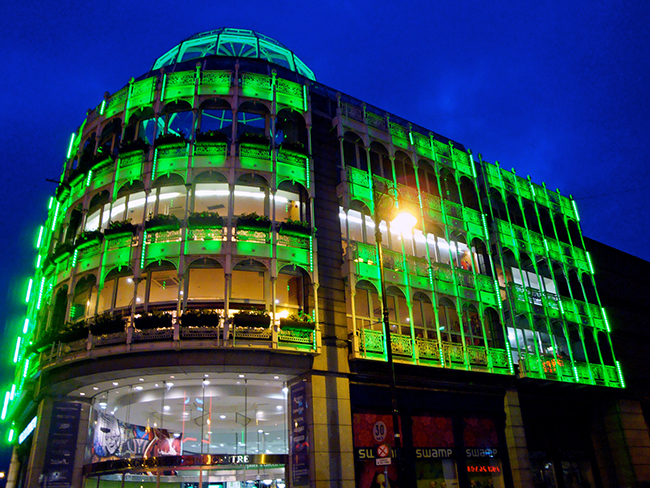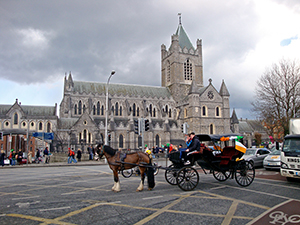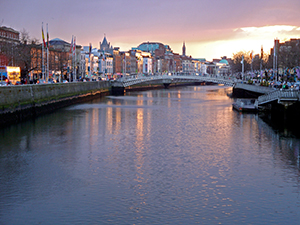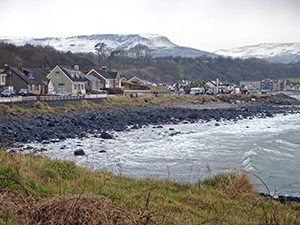Shamrock City: St. Patrick’s Day in Dublin

By Richard C. Murray and Laurie Heifetz
Photos by Richard C. Murray/RCM IMAGES, INC
When one thinks of jamborees, Carnival in Rio, New Year’s Eve in Beijing and Mardi Gras in New Orleans may come to mind. We, however, left JFK Airport and crossed the Atlantic to check out St. Patrick’s Day in Dublin. We felt the excitement as soon as we entered Dublin Airport. Dazzling green, white and orange balloons—announcing the five-day, St. Patrick’s festival—decorated the terminals. These colors represent Ireland’s flag. The green on the left denotes the Catholic, nationalist communities; the orange on the right, the Protestant, loyalist community; and the white in the center, the hope for peace between the two.
We arrived early in the morning at the Burlington Hotel. This four-star property is frequented by Irish sports teams and residents of neighboring counties. The Canal Bank restaurant is a hidden treasure across the street. Just ask the Jennifers—Lopez and Aniston who have dined here. Everything is made on the premises, including smoked relish, roasted-garlic aioli and ice cream.
A highlight of our trip was meeting the President of Ireland, Michael D. Higgins, at his residence (Áras an Uachtaráin). The accomplished poet and author cordially posed with us for photos before tea and hors d'oeuvres. The following day, we took a ride up the beautiful coast to the majestic, twelfth-century Malahide Castle and Gardens. The Talbot family of Ireland maintained the property for 800 years, preventing attrition. Magnificent peacocks lumbered about the gardens and ancient structures. On the ride back, we stopped at two breathtaking resort towns in Fingal county. We photographed the Baily Lighthouse on Howth Head peninsula and Martello Tower on the Portmarnock shore. After working up a prodigious appetite, we ate a dozen miniature cheeseburgers during an Irish-whiskey presentation at Dublin’s 37 Dawson Street restaurant.

Equipped with attraction maps and hop-on, hop-off green bus passes, we ventured forward. The imposing Christ Church Cathedral (c. 1028)—a medieval, Anglican edifice—has an underground crypt filled with historical artifacts. It’s the largest in Ireland and Britain. For dinner, it was off to the Saddle Room restaurant, housed in the five-star Shelbourne hotel overlooking St. Stephen’s Green. A spectacular evening of traditional Irish music and dance at Dublin’s National Concert Hall awaited us. Featured-artist Martin Hayes mesmerized the audience with a series of medleys. He has the distinction of winning six “All-Ireland” fiddle championships, and all before the age of nineteen!
We woke up early on St. Patrick’s Day and visited the Dublin Writers Museum—located a few feet from the start line of the parade. We marveled at original works from the world-famous Irish writers—Wilde, Joyce, Beckett, Swift, Shaw. The parade had an added dimension this year. Eight thousand people worldwide were invited to march—referred to as the “People’s Parade.” We met participants from countries as far away as India, Brazil and China—all in traditional, festive dress.
Purdue University entertained with the world’s largest drum. The Fire Department of New York EMS Pipes and Drums Band set the spectators ablaze, just one day after it marched on Manhattan’s Fifth Avenue. Green hats, green ties, green face paint and green clothes permeated the shamrock city. We fought through the crowds to get to the Central Hotel. Its award-winning Library Bar is arguably the best hotel watering hole in the city.

When in Dublin, do as the Irish do—go for a pint! And what better place than the Guinness Storehouse, begun in 1759. Ireland’s top visitor attraction fuses centuries-old tradition and ultramodern architecture. The center of the brewery is adorned with a seven-story glass atrium. It’s the world’s largest pint glass and can hold 14.3 million pints of stout.
Early the next morning, we commenced on a tour of Northern Ireland, U.K. The world-renowned Antrim Coast is a must-see. The awe-inspiring English Channel merges the Irish Sea and Atlantic Ocean. Fishing marinas peppered with red and black rocks, snowcapped mountains and grazing fauna resemble classic paintings. The Carrick-a-Rede Rope Bridge connects the mainland to the tiny, rocky island of Carrick A Rede. It stands 98 feet above the North Atlantic Ocean and spans 66 feet in length. Untamed waters crash against purple, green and brown-hued cliffs. Contrary to what one may presume, the bridge is very sturdy and the walk back and forth is untroubled.
Nearby is Giant’s Causeway, one of the greatest, natural enigmas in the world. Forty thousand basalt columns, mainly hexagonal, were formed about 60 million years ago by volcanic eruptions. Diverse formations of adobe-red columns—ranging from a few inches to forty feet in height—silhouette a bright-blue ocean.
The Bushmills Inn is the place to stay when traveling the 120-mile Causeway Coastal Route. Each of the 41, unique rooms is named after a different Irish whiskey. The movie theatre, rustic sitting rooms, restaurant and outdoor patio are all charming. This four-star, boutique hotel even has its own helipad.

Our next day began with a quick stop at nearby Dunluce Castle, a seventeenth-century, medieval fortress in ruin. Perched on top on a steep cliff, its presence is grand. The surrounding coastal scenery is stunning. After driving back to Dublin, we stayed at the five-star Westbury Hotel. In the heart of the city, near Trinity College and the Book of Kells (c. 800), it has been visited famous faces like by Audrey Hepburn, David Bowie and Johnny Depp.
The night before our departure, we were lucky enough to get seated for dinner at Fade Street Social—the new hotspot from celebrity chef Dylan McGrath. The tasty veal chop for two with Dublin bay prawns and chervil was “cooked with charcoal and different woods to create smoky flavours.”
St. Patrick’s Day in Dublin and a tour up the north coast were an unbeatable experience. We can’t wait to return to tour the south!
visitDublin.com discovernorthernireland.com



